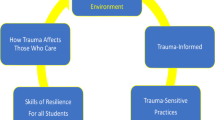Abstract
Educators demonstrate compassionate caregiving to students who experience traumatic loss from violence, natural causes, and health issues. Theorists raise critical issues about caregiving pedagogies, specifically the potentially limiting public displays of mourning in schools. This essay analyzes such theories in relation to three traumatic case studies: a teacher’s response to a student’s death caused by physical conditions, a student teacher’s response to the violent death of a high school student, and experiences by counselors who participated in a camp for youth whose siblings were diagnosed with terminal illness. Guiding research questions include: What are the salutogenic factors that affect youth who are engaged with trauma? How do teachers and counselors integrate the cognitive, behavioral, experiential, and spiritual aspects of well-being? The research provides a critical analysis of camp and school based responses to grief.
Similar content being viewed by others
References
Ahmed, S. (2004). The cultural politics of emotion. Edinburg: Edinburg University Press.
American Psychological Association (n.d.) Resilience guide: For parents & teachers. Retrieved September 20, 2013, from http://www.apa.org/helpcenter/resilience.aspx.
Anandarajah, G., & Hight, E. (2001). Spirituality and medical practice: using the HOPE questions as a practical tool for spiritual assessment. American Family Physician, 63(1), 81–88.
Antonovsky, A. (1979). Health, stress, and coping. San Francisco: Jossey-Bass.
Becker, C. M., Glascoff, M., & Felts, W. M. (2010). Salutogenesis thirty years later: where do we go from here? International Electronic Journal of Health Education, 13, 25–32.
Butler, J. (1997). The psychic life of power: theories in subjection. Palo Alto: Stanford University Press.
Derrida, J. (2001). The work of mourning. Chicago: University of Chicago Press.
Fields, F. (Producer) & Zwick, E. (Director) (1989). Glory [Motion picture]. United States: TriStar Pictures.
Golding, W. (1954). Lord of the flies. London: Faber and Faber.
Hunt, I. (1964). Across five Aprils. Chicago: Follett.
Nugteren, A. (2001, April). Collective/public ritual behaviour after disasters: an emerging manifestation of civil religion? Center for Studies on New Religions (CESNUR). Paper presented at the “Spiritual Supermarket” Conference, London School of Economics, London, United Kingdom. Retrieved September 20, 2013, from http://www.cesnur.org/2001/london2001/nugteren.htm.
Page, R. M., & Page, T. S. (2011). Promoting health and emotional well-being in your classroom. Sudbury: Jones and Bartlett.
Polacco, P. (1994). Pink and say. New York: Philomel.
Robben, A. C. (Ed.). (2004). Death, mourning, and burial: a cross-cultural reader. Oxford: Blackwell.
Sagberg, S., & Røen, I. (2011). Social practices of encountering death: a discussion of spiritual health in grief and the significance of worldview. International Journal of Children’s Spirituality, 16(4), 347–360.
Stern, M. S. (1994). Facing history and ourselves: holocaust and human behavior. Brookline: Facing History and Ourselves.
Trauma (2013). In Encarta World English Dictionary [North American Edition]. Retrieved September 20, 2013, from http://www.bing.com/Dictionary/search?q=define+trauma.
Yamamoto, K. (Ed.). (1978). Death in the life of children. Indianapolis: Kappa Delta Pi Press.
Zembylas, M. (2009). Making sense of traumatic events: toward a politics of aporetic mourning in educational theory and pedagogy. Educational Theory, 59(1), 85–104.
Author information
Authors and Affiliations
Corresponding author
Rights and permissions
About this article
Cite this article
McEachron, G. Compassion for the Young Experiencing the Trauma of Death. Journ Child Adol Trauma 7, 63–72 (2014). https://doi.org/10.1007/s40653-014-0005-0
Published:
Issue Date:
DOI: https://doi.org/10.1007/s40653-014-0005-0



